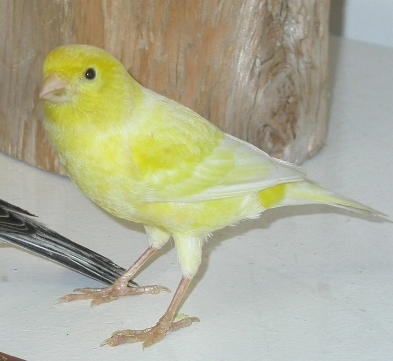
How apropos that we were tweeting throughout January about the bird with the famous voice! But now that January is just about over, it’s time for the canary to fly out of the spotlight as our Animal of the Month. We hope you’ve been following us on Twitter @ExoticPetVets all month long while we tweeted about our feathered friends. But if you missed any tweets, here is a summary. Did you know?:
- The canary (Serinus canaria) is one of the most popular pet birds, second only to the budgie.
- The domesticated canary is descended from wild canaries which originate from the Azores, Madeira and Canary Islands.
- Feral canary populations have been reported in Bermuda, Puerto Rico & Hawaii resulting from escaped captive canaries.
- Wild canaries are either typically yellow-green, with brownish streaks on the back, or grey or green.
- Domesticated canaries got their famous yellow colour through selective breeding which dates back to about the 1600’s.
- Modern domesticated canaries have been selectively bred into different colour, song and appearance variations.
- Many people choose to have canaries as pet birds because of their marvelous singing ability.
- Did you know that male canaries sing better than females? And some female canaries don’t sing at all.
- Dutch research suggests testosterone plays a part in why male canaries sing more than females.
- Canaries are small birds and are in the finch family.
- The average adult canary weighs just 0.7 – 0.8 ounces (20 – 22 grams) and is 5 – 5.5 inches (12.5 – 14 cm) in length.
- Canaries are relatively easy to care for in captivity.
- Canaries are good-natured and can be good for children to learn the responsibility of caring for a pet.
- The term “canary in a coal mine” comes from humans using canaries as a sentinel species in mining.
- Physiologist John Scott Haldane devised the idea to use canaries to detect toxic gases in mines circa the early 1900s.
- Canaries have delicate respiratory systems and if they showed signs of distress in a mine it was deemed unsafe for humans.
- Canaries were used to detect toxic gases in British coal mines dating back to 1911.
- The use of canaries in British coal mines started to be phased out in 1987 in favour of electronic gas detectors.
- Like “canary in a coal mine,” “climate canary” suggests canaries are a sentinel species for environmental disaster.
- The American Dialect Society declared “climate canary” the most useful word for 2006.
- Canaries have been depicted in comics and cartoons, their relationship with cats or pollution are common themes.
- The most famous cartoon canary is Warner Bros.’s Tweety Bird.
- DC Comics created superhero Black Canary who made her comic book debut in 1947.
- As a nod to the canary’s voice, Black Canary can unleash destructive sonic sound waves, known as her “Canary Cry.”

